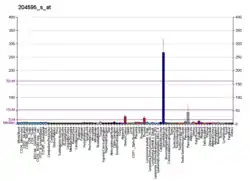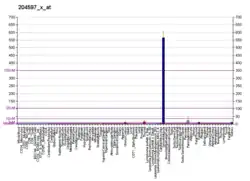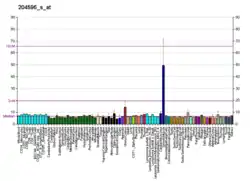STC1
Stanniocalcin-1 is a glycoprotein, a homologue of a hormone stanniocalcin, first discovered in bony fishes. In humans it is encoded by the STC1 gene.[4][5]
Function
This gene encodes a secreted, homodimeric glycoprotein that is expressed in a wide variety of tissues and may have autocrine or paracrine functions. The only known molecular function of human Stanniocalcin-1 to date is a SUMO E3 ubiquitin ligase activity in the SUMOylation cycle. However, STC1 interacts with many proteins in the cytoplasm, mitochondria, endoplasmatic reticulum, and in dot-like fashion in the cell nucleus. The N-terminal region of STC1 is the function region which is responsible to establish the interaction with its partners, including SUMO1.[6] Low-resolution studies shows that STC1 is an anti-parallel homodimer in solution and the cysteine 202 is responsible for its dimerization. All the 5 disulfide bonds of human STC1 are conserved and have the same profile of fish STC.[7] The gene contains a 5' UTR rich in CAG trinucleotide repeats. The encoded protein contains 11 conserved cysteine residues and is phosphorylated by protein kinase C exclusively on its serine residues.
The protein may play a role in the regulation of renal and intestinal calcium and phosphate transport, cell metabolism, or cellular calcium/phosphate homeostasis. Overexpression of human stanniocalcin 1 in mice produces high serum phosphate levels, dwarfism, and increased metabolic rate. This gene has altered expression in hepatocellular, ovarian, and breast cancers,[5] and is a putative molecular biomarker of leukemic microenvironment.
References
- GRCh38: Ensembl release 89: ENSG00000159167 - Ensembl, May 2017
- "Human PubMed Reference:". National Center for Biotechnology Information, U.S. National Library of Medicine.
- "Mouse PubMed Reference:". National Center for Biotechnology Information, U.S. National Library of Medicine.
- Chang AC, Jeffrey KJ, Tokutake Y, Shimamoto A, Neumann AA, Dunham MA, Cha J, Sugawara M, Furuichi Y, Reddel RR (Feb 1998). "Human stanniocalcin (STC): genomic structure, chromosomal localization, and the presence of CAG trinucleotide repeats". Genomics. 47 (3): 393–8. doi:10.1006/geno.1997.5120. PMID 9480753.
- "Entrez Gene: STC1 stanniocalcin 1".
- dos Santos MT, Trindade DM, Gonçalves Kde A, Bressan GC, Anastassopoulos F, Yunes JA, Kobarg J (Jan 2011). "Human stanniocalcin-1 interacts with nuclear and cytoplasmic proteins and acts as a SUMO E3 ligase". Molecular BioSystems. 7 (1): 180–93. doi:10.1039/c0mb00088d. PMID 21042649.
- Trindade DM, Silva JC, Navarro MS, Torriani IC, Kobarg J (Aug 27, 2009). "Low-resolution structural studies of human Stanniocalcin-1". BMC Structural Biology. 9: 57. doi:10.1186/1472-6807-9-57. PMC 2744999. PMID 19712479.
Further reading
- Chang AC, Jellinek DA, Reddel RR (Sep 2003). "Mammalian stanniocalcins and cancer". Endocrine-Related Cancer. 10 (3): 359–73. CiteSeerX 10.1.1.318.655. doi:10.1677/erc.0.0100359. PMID 14503913.
- Liang P, Averboukh L, Keyomarsi K, Sager R, Pardee AB (Dec 1992). "Differential display and cloning of messenger RNAs from human breast cancer versus mammary epithelial cells". Cancer Research. 52 (24): 6966–8. PMID 1458489.
- Chang AC, Janosi J, Hulsbeek M, de Jong D, Jeffrey KJ, Noble JR, Reddel RR (Aug 1995). "A novel human cDNA highly homologous to the fish hormone stanniocalcin". Molecular and Cellular Endocrinology. 112 (2): 241–7. doi:10.1016/0303-7207(95)03601-3. PMID 7489828. S2CID 35823912.
- Wagner GF, Guiraudon CC, Milliken C, Copp DH (Mar 1995). "Immunological and biological evidence for a stanniocalcin-like hormone in human kidney". Proceedings of the National Academy of Sciences of the United States of America. 92 (6): 1871–5. doi:10.1073/pnas.92.6.1871. PMC 42384. PMID 7892193.
- Olsen HS, Cepeda MA, Zhang QQ, Rosen CA, Vozzolo BL, Wagner GF (Mar 1996). "Human stanniocalcin: a possible hormonal regulator of mineral metabolism". Proceedings of the National Academy of Sciences of the United States of America. 93 (5): 1792–6. doi:10.1073/pnas.93.5.1792. PMC 39860. PMID 8700837.
- Zhang KZ, Westberg JA, Paetau A, von Boguslawsky K, Lindsberg P, Erlander M, Guo H, Su J, Olsen HS, Andersson LC (Aug 1998). "High expression of stanniocalcin in differentiated brain neurons". The American Journal of Pathology. 153 (2): 439–45. doi:10.1016/S0002-9440(10)65587-3. PMC 1852984. PMID 9708804.
- Varghese R, Wong CK, Deol H, Wagner GF, DiMattia GE (Nov 1998). "Comparative analysis of mammalian stanniocalcin genes". Endocrinology. 139 (11): 4714–25. doi:10.1210/en.139.11.4714. PMID 9794484.
- Zhang Kz, Lindsberg PJ, Tatlisumak T, Kaste M, Olsen HS, Andersson LC (Mar 2000). "Stanniocalcin: A molecular guard of neurons during cerebral ischemia". Proceedings of the National Academy of Sciences of the United States of America. 97 (7): 3637–42. doi:10.1073/pnas.070045897. PMC 16292. PMID 10725397.
- Jellinek DA, Chang AC, Larsen MR, Wang X, Robinson PJ, Reddel RR (Sep 2000). "Stanniocalcin 1 and 2 are secreted as phosphoproteins from human fibrosarcoma cells". The Biochemical Journal. 350 Pt 2 (2): 453–61. doi:10.1042/0264-6021:3500453. PMC 1221272. PMID 10947959.
- Varghese R, Gagliardi AD, Bialek PE, Yee SP, Wagner GF, Dimattia GE (Mar 2002). "Overexpression of human stanniocalcin affects growth and reproduction in transgenic mice". Endocrinology. 143 (3): 868–76. doi:10.1210/en.143.3.868. PMID 11861508.
- McCudden CR, James KA, Hasilo C, Wagner GF (Nov 2002). "Characterization of mammalian stanniocalcin receptors. Mitochondrial targeting of ligand and receptor for regulation of cellular metabolism". The Journal of Biological Chemistry. 277 (47): 45249–58. doi:10.1074/jbc.M205954200. PMID 12223480.
- Serlachius M, Alitalo R, Olsen HS, Andersson LC (Nov 2002). "Expression of stanniocalcin-1 in megakaryocytes and platelets". British Journal of Haematology. 119 (2): 359–63. doi:10.1046/j.1365-2141.2002.03916.x. PMID 12406069. S2CID 19633381.
- Sheikh-Hamad D, Bick R, Wu GY, Christensen BM, Razeghi P, Poindexter B, Taegtmeyer H, Wamsley A, Padda R, Entman M, Nielsen S, Youker K (Jul 2003). "Stanniocalcin-1 is a naturally occurring L-channel inhibitor in cardiomyocytes: relevance to human heart failure". American Journal of Physiology. Heart and Circulatory Physiology. 285 (1): H442–8. doi:10.1152/ajpheart.01071.2002. PMID 12663264.
- Zlot C, Ingle G, Hongo J, Yang S, Sheng Z, Schwall R, Paoni N, Wang F, Peale FV, Gerritsen ME (Nov 2003). "Stanniocalcin 1 is an autocrine modulator of endothelial angiogenic responses to hepatocyte growth factor". The Journal of Biological Chemistry. 278 (48): 47654–9. doi:10.1074/jbc.M301353200. PMID 14500721.
- McCudden CR, Majewski A, Chakrabarti S, Wagner GF (Jan 2004). "Co-localization of stanniocalcin-1 ligand and receptor in human breast carcinomas". Molecular and Cellular Endocrinology. 213 (2): 167–72. doi:10.1016/j.mce.2003.10.042. PMID 15062564. S2CID 29530147.
- Luo CW, Kawamura K, Klein C, Hsueh AJ (Aug 2004). "Paracrine regulation of ovarian granulosa cell differentiation by stanniocalcin (STC) 1: mediation through specific STC1 receptors". Molecular Endocrinology. 18 (8): 2085–96. doi:10.1210/me.2004-0066. PMID 15131261.
- Serlachius M, Andersson LC (Jun 2004). "Upregulated expression of stanniocalcin-1 during adipogenesis". Experimental Cell Research. 296 (2): 256–64. doi:10.1016/j.yexcr.2004.02.016. PMID 15149855.




